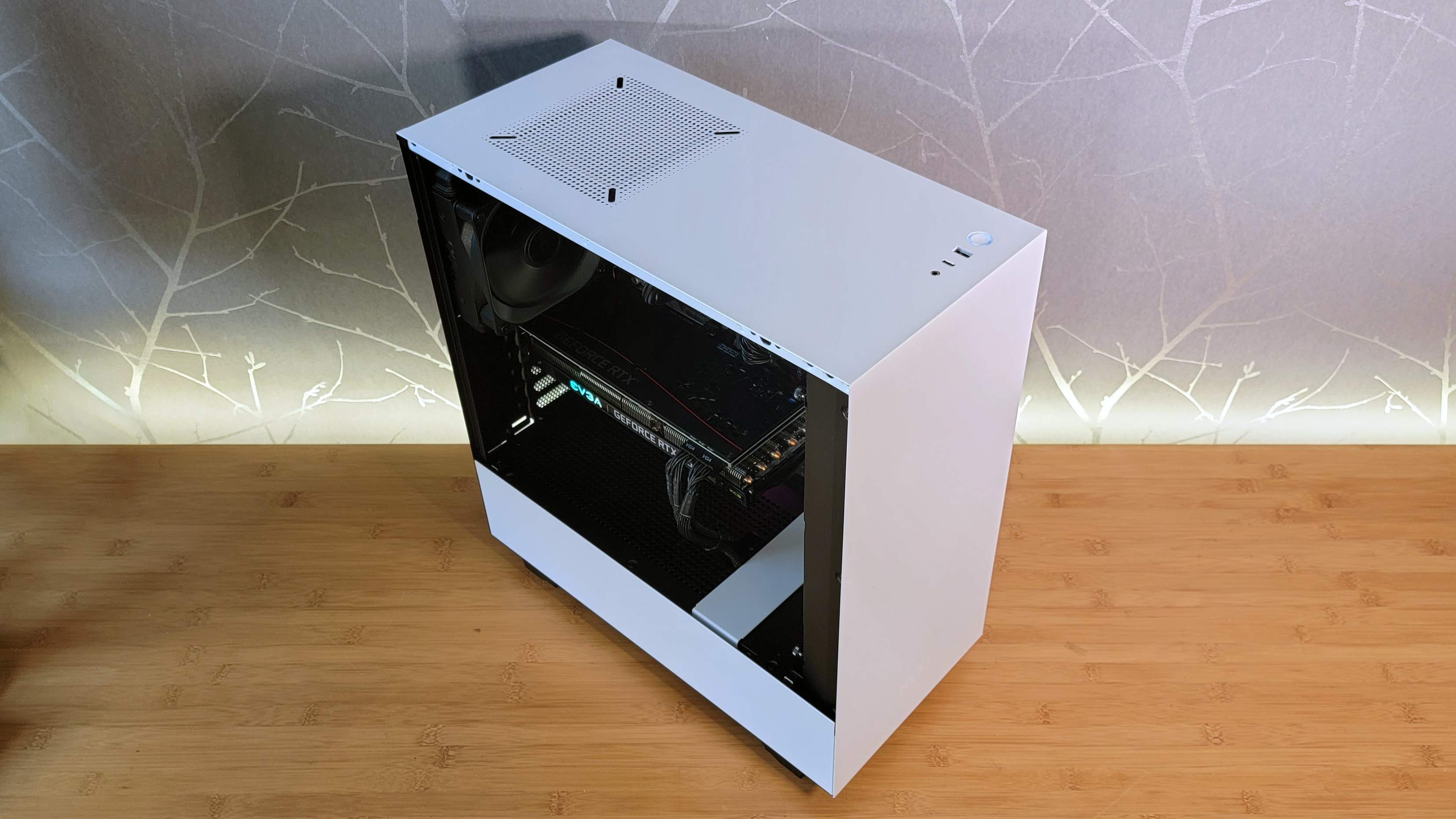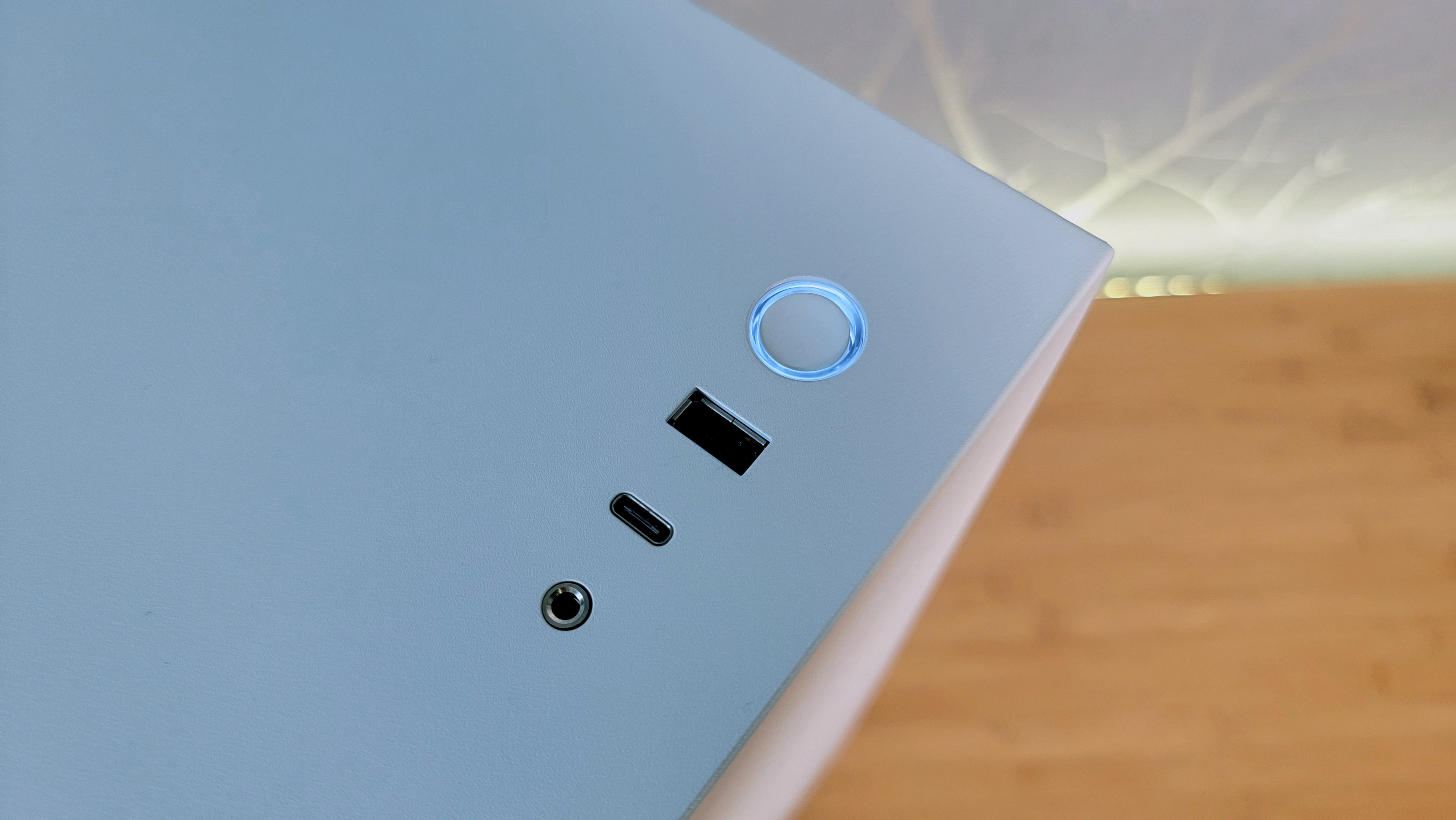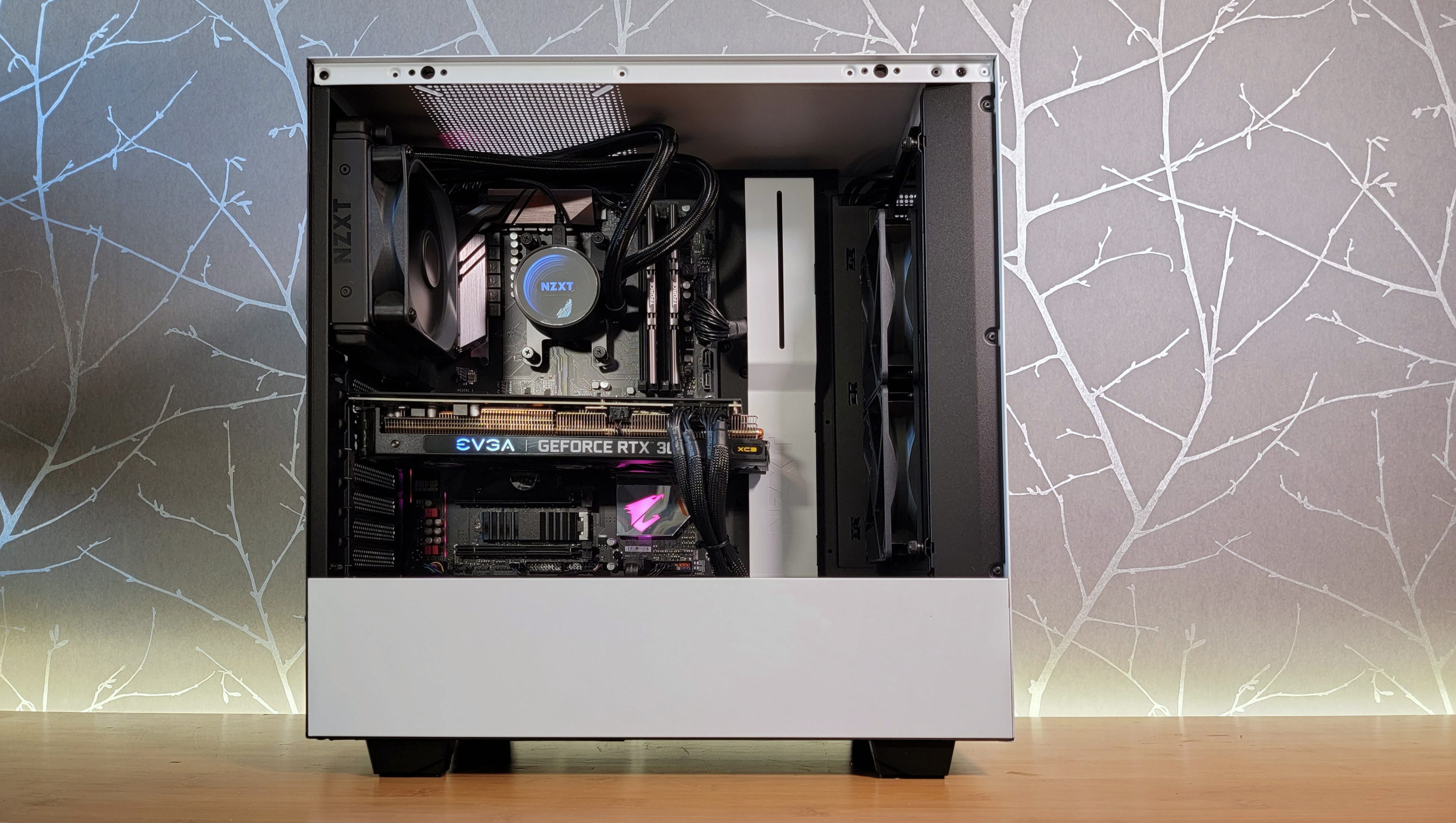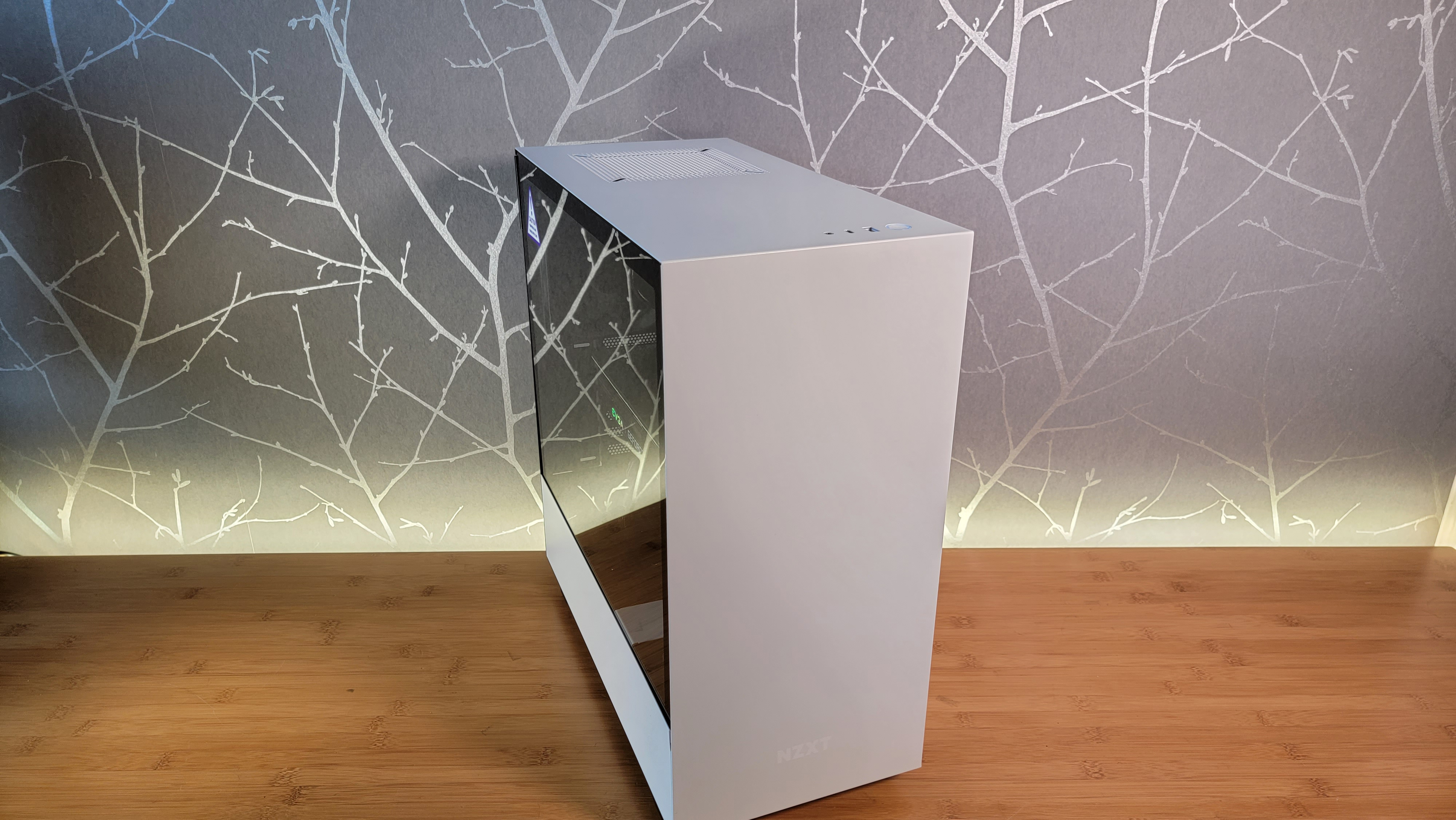Tom's Hardware Verdict
Competently and cleanly assembled, with well-chosen parts for this price range, NZXT’s Streaming Plus PC is a solid option to get your PC gaming on—especially if you like its understated looks.
Pros
- +
+ Immaculately clean Windows 10 install
- +
+ Understated good looks
- +
+ Solid performance
Cons
- -
Ships with XMP disabled
- -
Limited storage (1TB) for games
- -
No streaming-specific features
Why you can trust Tom's Hardware
While the overall price and availability of graphics cards may be slowly improving, it’s still next to impossible to buy a modern GPU on its own at anything close to MSRP. That means pre-built desktops like NZXT’s Streaming Plus ($1,999 as tested) are still a popular choice for PC gamers, so plenty of people are aftter one of the best gaming PCs, whether they need a whole new system or not. If you need a powerful GPU, it’s one of the only ways to get one without paying exorbitant prices just for a graphics card. Just don’t expect to find any streaming-specific hardware or features here. Despite the name, the Streaming Plus is just a typical gaming PC. It’s certainly capable of streaming, you’ll just want to do so using the graphics card and Nvidia Broadcast.
For $1,999 in our NZXT Streaming Plus test configuration, you get a potent combo of a six-core Ryzen 5 5600X CPU and an RTX 3070. That’s not quite flagship-class hardware, but as we’ll see in testing, it’s plenty capable of handling today’s most-demanding games. Considering all the in-stock RTX 3070 cards on Newegg when we wrote this were selling for over $1,000, it’s also arguably a decent value in today’s world of silicon scarcity. NZXT also throws in its popular H510 case and a Kraken M22 AIO cooler, plus a 1TB NVMe SSD and 16GB of RAM.
Note that the RAM here is also dual-channel, rather than the performance-limiting single stick you’ll often get with lower-cost gaming rigs from big-box brands like Dell/Alienware, Acer or HP. Just note that, oddly, NZXT doesn’t ship its systems with XMP memory profiles enabled. So if you want to get the best gaming performance possible from your rig, the first thing you’ll want to do is jump into the BIOS and enable the faster speeds.
Design of the NZXT Streaming Plus
Regardless of configuration, NZXT’s Streaming and Streaming Plus PCs ship in the company’s H510 case (in your choice of black or white), which does a nice job of presenting your core components behind its glass side panel. It also hides much of the cabling behind a power supply shroud and a metal bar that runs vertically down the interior, in front of the motherboard.
Visually, the system is clean, if not exactly flashy by modern gaming rig standards. The three included fans don’t have lights. The little light show there is comes from the infinity mirror light ring in the company’s Kraken M22 AIO cooler, from the chipset cooler on the Aorus motherboard, and from the graphics card — an EVGA RTX 3070 model in our review unit. In short, there’s a bit of a glow here if the lights are low, but the RGBs are far from overpowering. Frankly, the stylistic modesty exhibited here is kind of refreshing.
The front of our review unit is a solid white steel, though the right side has ample holes for intake via the two front fans. There’s also a perforated area up top for airflow (where you could also add another fan). On top, near the front is a pleasing power button, a single audio jack and two USB ports, one Type C and one Type A. The USB-C port didn’t work on our review unit, but NZXT says newer models with B550 motherboards will have a functioning Type-C port. Much like the visual design, the cooling and ports here aren’t exactly luxurious, but they get the job done without much in the way of major complaints.
In terms of rear ports and upgradability, your mileage will vary — at least from our review unit. NZXT shipped our system with a Gigabyte B450 Aorus Pro WiFi board. But a last-minute change (which an NZXT rep told us was due to recently enacted CEC guidelines) means new systems will ship with newer B550 boards instead. Which specific board you get will vary depending on availability of stock. That makes a discussion of the USB ports and expandability here a bit moot. But in general this change is better for customers, because the B550 chipset will grant you access to the faster PCIe 4.0 lanes available on the Ryzen 5 5600X CPU. That shouldn’t significantly change the performance we saw in testing, but it will let you upgrade to, say, a super-fast PCIe 4.0 SSD or a higher-bandwidth graphics card down the road without having to splurge on a new motherboard.
Get Tom's Hardware's best news and in-depth reviews, straight to your inbox.
NZXT Streaming Plus Specifications
| Processor | AMD Ryzen 5 5600X |
| Motherboard | B450 Aorus Pro WiFi (as tested), B550 boards will ship with new systems |
| Memory | 16GB T-Force DDR4-3200 (as tested), new systems ship with DDR4-3000 |
| Graphics | EVGA RTX 3070 XC3 (8GB) |
| Storage | 1TB Western Digital WD Blue SN550 NVMe SSD |
| Case | NZXT H510 |
| Networking | Intel Dual Band Wireless-AC 9260 (on motherboard), Bluetooth 4.2 |
| Front Ports | 2x USB 3.0 (Type C, Type A), 3.5mm headphone/microphone combo jack |
| Rear Ports (Motherboard) | Dependant on motherboard |
| Video Output (GPU) | 3x DisplayPort 1.4a, HDMI 2.1 |
| Power Supply | 80 Plus Bronze 650W |
| Cooling | NZXT Kraken M22 120mm AIO |
| Operating System | Windows 10 Home |
| Dimensions | 18.11 x 16.85 x 8.27 inches / 460 x 428x 210 mm |
| Price as Configured | $1,999.99 |
Gaming and Graphics on the NZXT Streaming Plus
The $1,999 configuration of the NZXT Streaming Plus PC we tested came with a six-core AMD Ryzen 5 5600X CPU and an EVGA RTX 3070 graphics card, along with a 1TB WD SN550 NVMe SSD and 16GB of RAM.
As we’ll soon see, that’s a very capable gaming combo. But aside from the motherboard shift to the B550 chipset, there are other changes between what the company sent us and what you’ll actually get if you buy the NZXT Streaming Plus yourself.
While NZXT advertises these systems as shipping with 16GB of DDR4 3000 RAM, the company does not enable the XMP profile for the RAM to actually run at that speed out of the box. It’s quite simple to do so yourself: Just jump into the BIOS and enter the Advanced Memory settings and enable Profile1 under Extreme Memory Profile (the first menu option), then hit F10 to save and exit.
That said, as our standard practice for testing desktops is to run benchmarks as the system ships (since that’s how the vast majority of buyers will use the system), we tested our NXXT Streaming Plus at the default memory settings, which for our T-Force memory was 2400 MHz. Enabling the faster RAM speed will mean better performance in some games. While this is technically overclocking, NZXT pointed out to us that its two-year warranty covers running your memory at these advertised settings, it just doesn’t enable them by default.
In the gaming tests below, as well as the following productivity tests, we put our configuration of the NZXT Streaming Plus up against other recent gaming desktops we’ve tested. The iBuypower Element CL Pro is seemingly this system’s closest competitor, as it ships at the same $1,999, also with an RTX 3070, 16GB of RAM and the same WD SN550 boot drive. Note though, for that price with iBuypower you also get snazzy-looking hardline tubing for cooling, rather than the AIO cooler on the NZXT model.
The HP Omen 30L we tested is much pricier at about $3,100 as tested, with an RTX 3080 and an Intel Core i9-10900K. And last up is the Alienware Aurora Ryzen Edition R10, which we tested earlier this year with a Ryzen 7 5800X, 32GB of RAM and an AMD RX 6800XT for $2,639.
In anecdotal testing, the system performed well during our time with it. I played through the opening section of The Ascent at 4K resolution with everything maxed out and the game ran between about 55 and 68 frames per second. It wouldn’t be difficult to dial back a setting or two to keep the frame rate at or above 60 fps.
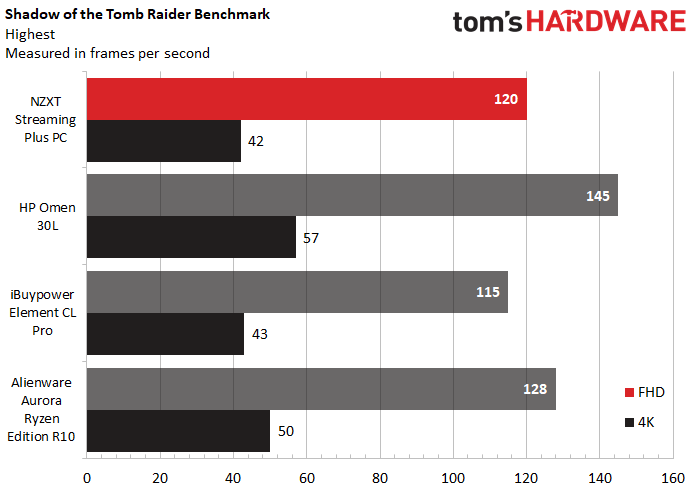
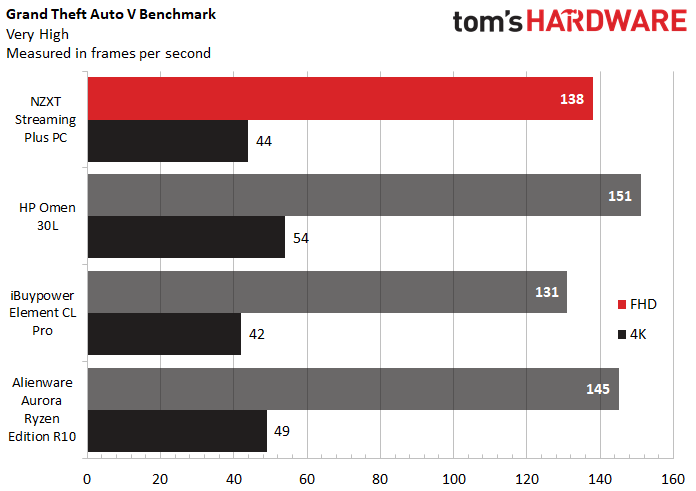
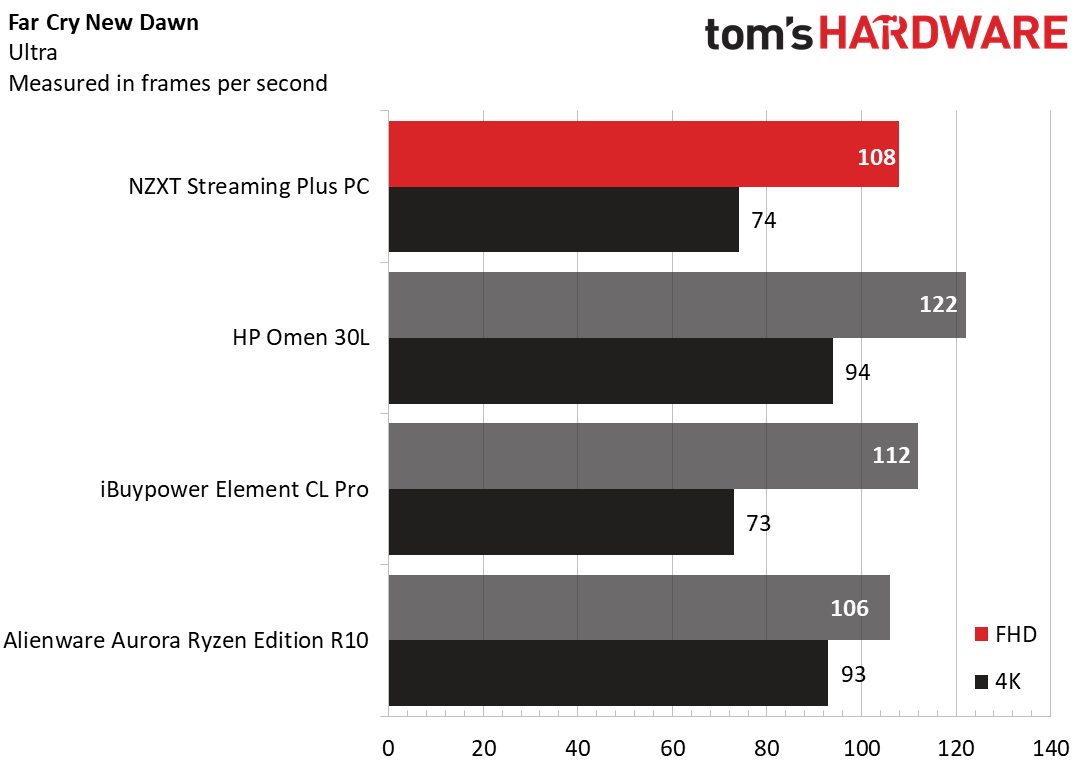
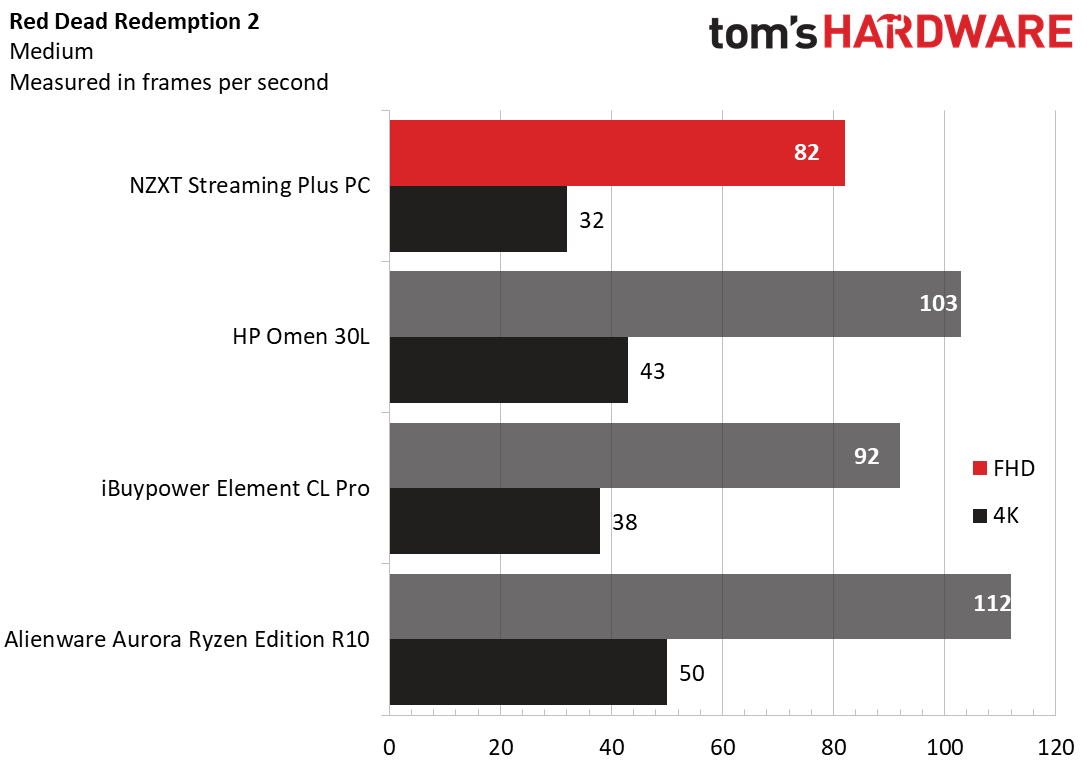
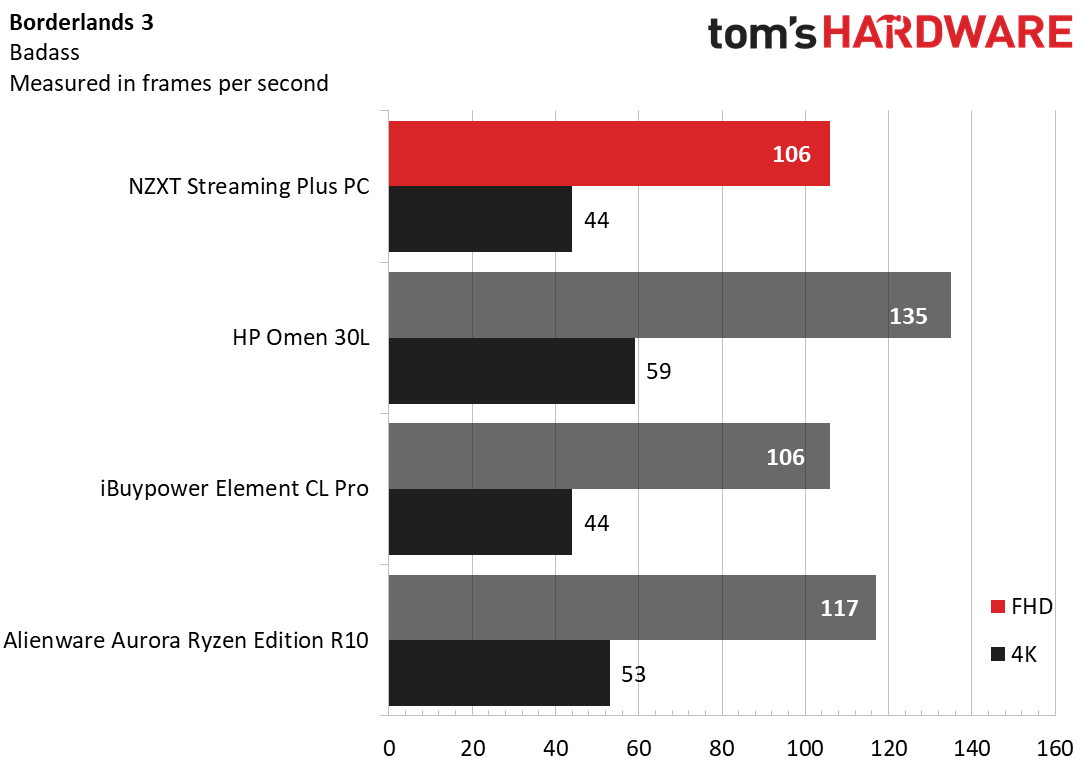
On Shadow of the Tomb Raider (highest settings), NXZT’s Streaming Plus traded blows with its closest competitor, the iBuypower system, pulling 5 fps ahead at 1080p (thanks largely to its current-gen AMD CPU), but landing a single frame behind at 4K. As expected, the two systems with more powerful Nvidia graphics cards did markedly better. They also cost much more.
On Grand Theft Auto V (very high), the NZXT system led the iBuypower by 7fps at 1080p and still led by a couple fps at 4K. Again the HP and Alienware were well ahead, thanks mostly to their higher-priced, higher-power core components.
Shifting to Far Cry New Dawn, the NZXT system again trailed the similarly equipped iBuypower slightly at 1080p, by 4fps, but its score of 74 fps at 4K was one frame ahead. Both the Alienware and the Omen were roughly 20 fps faster at 4K.
The NXZT system arguably looked its worst on Red Dead Redemption 2 (medium settings). Its score of 82 fps at 1080p and 32 fps at 4K was respectable. But with its similar hardware (and faster clocked RAM), the iBuypower system was 10 fps faster at 1080p and 6 fps faster at 4K. Again, the NZXT system is capable of faster memory clock speeds, which would likely help it here (and elsewhere), but the company doesn’t ship its systems with its memory profile enabled out of the box. So our testing was run at 2400 MHz.
Lastly, in Borderlands 3, the NZXT and iBuypower systems were dead-even on the Badass preset. Both systems scored 106 fps at 1080p and 44 fps at 4K. The HP Omen, with its RTX 3080, did significantly better here, hitting 135fps at 1080p and nearly 60fps at 4K.
We also stressed the NZXT Streaming Plus with our Metro Exodus gauntlet, running the test 15 times on the RTX preset. The game ran at an average of 82.23 frames per second, once jumping just above 83 fps and dipping to 81 fps on one run. The CPU ran at an average of 4.3 GHz and an average temperature of 63.13 degrees Celsius (145.63 degrees Fahrenheit). The graphics card ran at an average of 1829 MHz and measured an average of 66.18 degrees Celsius (151.12 degrees Fahrenheit).
Productivity Performance on the NZXT Streaming Plus
Aside from capable AAA gaming performance, NZXT’s Streaming Plus is also quite a capable productivity rig, thanks to its 12-thread Ryzen 5 CPU and 16GB of RAM. Just know that the CPU here can’t always compete with pricier, more powerful rigs. HP’s Omen 30L had a top-end, 20-thread Intel Core i9-10900K as tested. And the Alienware rig sports AMD’s flagship Ryzen 7 5800X, with 16 threads. So don’t expect the lower-priced six-core NZXT rig to lead here either. But that doesn’t mean it can’t compete, either.
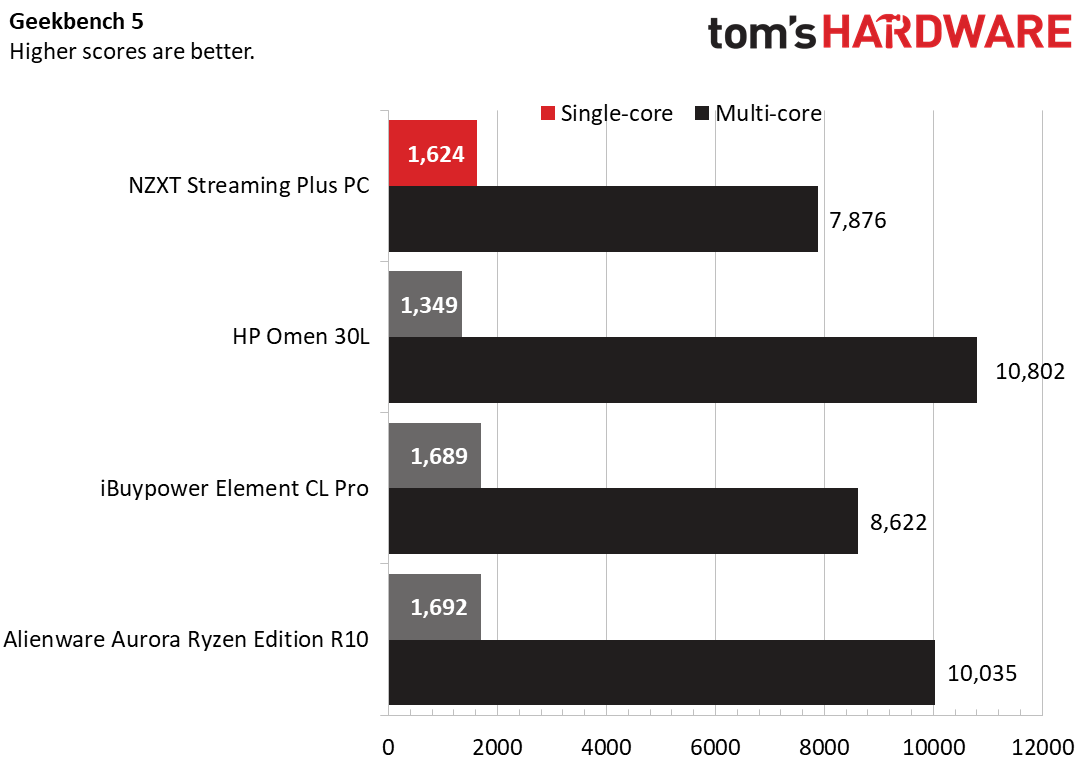
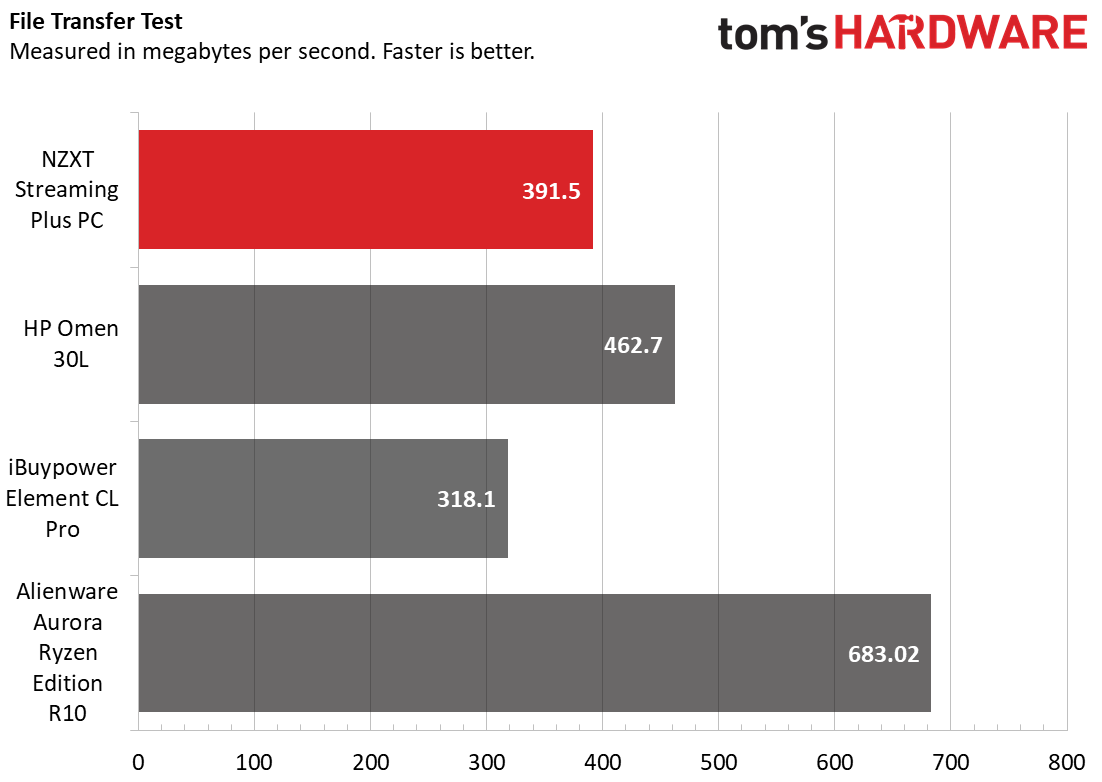
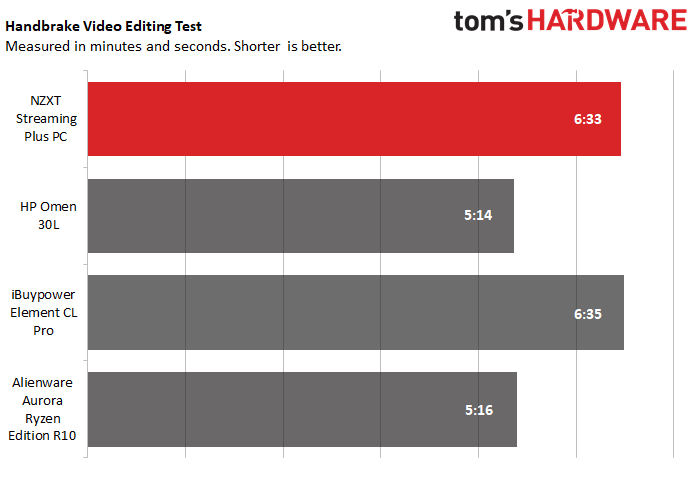
Starting with Geekbench 5, NZXT’s rig did manage to best the Intel-Powered HP Omen in the single-core test, while getting close to the Alienware. But taking all cores into account, it was trounced by everything here. Even the iBuypower system did markedly better, likely thanks to its more complex (and prettier) hardline cooling system.
The iBuypower and NZXT systems effectively tied on our Handbake test, despite the fact that the former has two more Intel-powered cores. But once again the HP and Alienware rigs easily led here.
Interestingly, while both the NZXT and iBuypower systems share the same WD SSD, the former pulled ahead in our 25GB file transfer test. Still, the WD drive, while an NVMe model, is far from one of the best SSDs; its speed of slightly under 400 MBps couldn’t keep up with the HP Omen 30L’s 463 MBps, let alone the Alienware Aurora’s 683 MBps.
Software and Warranty on the NZXT Streaming Plus
One of the more pleasing things about NZXT’s Streaming Plus rig is just how clean its desktop is when you fire it up for the first time. Our desktop featured a familiar Windows 10 background, and just a few shortcuts for the company’s CAM monitoring software, RGBFusion for motherboard lighting, and Nvidia’s Control Panel. There’s also a shortcut for Edge, but nobody’s perfect.
Pre-installed software is similarly minimal. Aside from what’s mentioned above, we didn’t notice much of anything extra. Even the usual Windows 11 bloat, like Candy Crush, or other gamers were absent. All I really noticed were a couple of Microsoft’s add-on apps, like Office and 365 for Enterprise. If you’re after a clean install of Windows, this is the best I’ve seen on a desktop in awhile.
NZXT sells the Streaming Plus with a two-year warranty on parts and labor.
Configurations of the NZXT Streaming Plus
NZXT offers its mid-tower ATX desktop in three configurations. The Streaming Plus PC we tested is $1,999 with a Ryzen 5 5600X CPU, an RTX 3080, and 16GB of RAM plus a 1TB NVMe SSD.
The $1,599 base model (Streaming PC, without the “Plus”) ships with the same Ryzen 5 CPU and RAM, but a previous-generation RTX 2060 and half the storage (500GB). Then the $2,999 Streaming PC Pro packs again the same Ryzen 5 5600X, but an RTX 3090, with the same 16GB of RAM and 1TB SSD as our review unit.
All three configurations now ship (according to NZXT) with B550 motherboards (rather than the B450 we got), as well as liquid cooling in the form the 120mm Kraken M22. The fact that liquid cooling and dual-channel memory is included here on all configurations is appreciated, and a step up from many big-box prebuilt gaming rigs, particularly those in the sub-$2,000 range.
Bottom Line
NZXT’s Streaming Plus is competently and cleanly assembled, and it performed about as we expected, trading blows with the similarly priced iBuypower CL Pro, which also sports an RTX 3070. Nothing about the NZXT’s design particularly stands out, and the similarly priced iBuypower system ships with a nicer hard-loop cooling system. But note that the iBuypower system has jumped $50 in pricing since we tested it, to $2,049 — and it was also sold out when we wrote this. That might have worked in the NZXT system’s favor, if the Streaming Plus wasn’t also sold out when we were wrapping up this review. Such are the hardware-limited times we live in, thanks to a combination of cryptomining, the ongoing pandemic, and ongoing import tariffs. Expect stock for most modern gaming PCs to be sporadic for at least the next few months.
NZXT’s combination of AMD’s Ryzen 5 5600 CPU and Nvidia’s RTX 3070, plus 16GB of RAM and a 1TB hard drive is easily powerful enough to play demanding modern games, although you’ll have to dial down some settings if you want to up the resolution to 4K. Also remember to enable the XMP profile in the system’s BIOS to get some extra frames on some games. It takes less than a minute, and you’re paying for memory that’s capable of faster speeds, so you don’t want to leave things at the slower default settings.
After a rough start with the Mattel Aquarius as a child, Matt built his first PC in the late 1990s and ventured into mild PC modding in the early 2000s. He’s spent the last 15 years covering emerging technology for Smithsonian, Popular Science, and Consumer Reports, while testing components and PCs for Computer Shopper, PCMag and Digital Trends.
-
NoFaultius Yea, that picture of the build and all the pictures on NZXT's website show their AIO cooler in that "tubes at the top" configuration. however the product literature says to put the tubes at the bottom. Marketing and engineering need to talk.Reply -
NaughtySunBro So if I was to get into the products they demo and what they deliver we'd have an interesting discussion.Reply
Lets talk something significantly less fun and less subjective.
What's the PC like after a year and a half of owning an NZXT machine?
We have an entry level gaming PC disguising itself as a middle ground enthusiast machine.
From questionable motherboard performance to slightly underwhelming cooling for the machine. The hardware itself isn't really the issue. The case itself being less than function for ports is only sort of an issue(3 failed ports; and one port that isn't performing properly) The motherboard itself will need an external bluetooth connector. As the built in one fails to impress. 2 failed USB ports on the back side aren't that much of an issue really. It's only ~50% of them. Not that much really.
The top case USB-C port being unreliable isn't anything exceptional but you'll probably want a docking station to actually get you a proper amount of functional ports.
Otherwise the GPU performs admirably. As it wasn't built by NZXT; and as such isn't subject to a high failure rate. All of the build issues and faulty components don't really hold a candle to my favorite feature of the machine.
Some really awful software called NZXT CAM; it can take fully functioning displays and reduce them to unreliable nonsense. It can simultaneously over and under allocate resources. Uninstalling NZXT CAM? Did you get suckered into a NZXT monitor. It probably wont work that well without it.
Overall quality review? Same league as Pokimane's Cookies. 7/10 "If you're a broke boi just say so." oh that'll be $28 dollars. Dont even think about going to get a costo prebuilt that's the same product only cheaper. How would the already rich eat?
